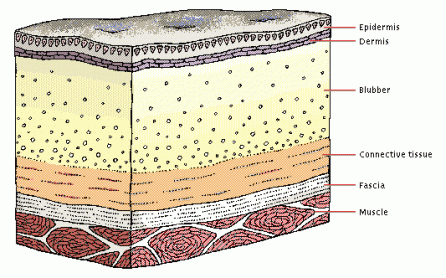
THERMOREGULATION
From special adaptations of their heart andf blood vessel, the storage of mass amounts of blubber stored to keep them warm, and behaviroala adaptations such as diving to deeper cooler waters to keep cool, blue whales have a myriad of ways to thermo regulate and thats what this page will dive deeper into.



Evolutionary Adaptations
Blue Whales have many adaptations that allow them to keep warm outside of insulation. One of which that they have a rather special method to keep the blood in their bodies warm when even in cooler areas.
Both series of the whales blood vessels, veins and arteries, run parallel to one another. What this does is generate a counter-current heat exchange system where the cold blood that is being pumped back to the heart from the extremities gets heated back up from the warm blood being pumped out of the heart. This basically means that blood going back to the animals core and heart doesn't lead to the whales core body temp to drop in colder climates.
Another way that blue whales use their vascular system in order to thermoregulate is that their blubber has a very dense collection of vessels in their blubber that only "open" when the whale is too hot. This allows the blood to flow through the blubber and then transfer the heat from the blubber to the extremities and achieve heat loss through the heat of the extremities.
The blubber is probably all whales most famous form of thermoregulation. While blue whales do have a thick layer of blubber between the skin and muscle fibers, it is not as thick as other whales, which is why they lean more on their other methods of keeping warm in cold waters.

Behavioral Adaptations
One behavioral form of thermoregulation in blue whales is rather simple, they will stay in waters that are comfortable for the whale. If they are finding the water too warm they will move father south or north of the equator and vice versa
Another Behavioral example of thromboregulations in blue whales is that when they are in warmer waters and they feel too warm, they will do one very deep dive where they will stay underwater for upwards of 30 minuets or until they get to a more suitable temperature before returning to normal behavior.

